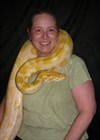|
Q:
|
What cleaning products do you all use for your Reptile enclosures?
|
|
I've used Virosan (Chlorhexidine) for years along with detergent for spot and weekly cleanings, along with the occasional water/bleach mixture. Recently I've been considering switching from Virosan to Lysol I.C. Quaternary Disinfectant and wanted to know if others used this product or what others are using to clean their enclosures?
|
|
Accepted Answer
|
11/23/2008 10:45:40 AM
|
|

FyreFocks
|
http://www.iherp.com/Answers/ReptileProblem.aspx?Id=2547
See this question.
|
|
|
|
|
|
|
|
Author Comment
|
11/23/2008 10:56:17 AM
|
|

ssscales
|
Thanks for the link, still figuring out how to get around this site and use a search feature...LOL
Great thread!
|
|
|
|
|
|
|
|
Member Comment
|
5/30/2013 4:02:17 AM
|
|

snlash
|
|
Actually (and you can google this to confirm), spraying your tanks with hydrogen peroxide then vinegar on top will actually clean AND sanitize far better than actual chlorine bleach does!! I've researched it a lot, and the combination of the vinegar on top of peroxide causes a harmless chemical reaction which sterilizes the area, and both peroxide and vinegar are very safe to clean with unlike bleach water. Just a suggestion!
“By itself, vinegar is not a disinfectant, but when used with hydrogen peroxide, it kills bacteria more effectively than any commercial cleaner. Susan Sumner, a food scientist at Virginia Polytechnic Institute and State University (VPI) in Blacksburg, Virginia, published the following formula in Science News. Purchase a bottle of 3 percent hydrogen peroxide and a bottle of plain white or apple cider vinegar. Pour each liquid into its own spray bottle. Spritz the item to be disinfected with both the vinegar and the hydrogen peroxide, then rinse with water. Using one mist right after the other is ten times more effective than usually spray by itself and more effective than mixing the vinegar and hydrogen peroxide in one spray bottle. Tests at VPI found the two sprays used together killed virtually all Salmonella, Shigella, or E. coli bacteria on heavily contaminated food and surfaces; this spray combination is more effective than chlorine bleach. It doesn’t matter if you spray with the vinegar first, then the hydrogen peroxide, or vice versa. There is no lingering taste of vinegar or hydrogen peroxide, and neither is toxic if any reside remains. This combination works exceptionally well for sanitizing counters and other food preparation surfaces, including wood cutting boards.” Natural Home magazine, Jan 2002
References: http://www.cooksinfo.com/peroxide-vinegar-sterilization
http://emilyslittlehomestead.wordpress.com/2012/08/17/natural-cleaning-vinegar-and-hydrogen-peroxide/
|
|
|
|
|
|
You are not logged in. If you would like to participate (it's free!), you must log
in, or Become a Member!
|
|
|
|
Most Popular Tags
Ball
,
Ballpython
,
Bci
,
Behavior
,
Boa
,
Breeding
,
Buying
,
Caging
,
Care
,
Chondro
,
Cornsnake
,
Crested
,
Crestedgecko
,
Eggs
,
Feeders
,
Feeding
,
Feedingproblems
,
Gecko
,
General
,
Genetics
,
GTP
,
Health
,
Heating
,
Humidity
,
Identification
,
Illness
,
Incubation
,
Infection
,
Leopardgecko
,
Mites
,
Morelia
,
Morph
,
Morphs
,
Parasites
,
Python
,
Regius
,
Respiratory
,
Shedding
,
Snake
,
Substrate
|
Latest Questions
|
|
|
|
points:150
|
|
|
|
points:100
|
|
|
|
points:250
|
|
|
|
points:100
|
|
|
|
points:250
|
More Questions
|
|
|
Latest Answers
|
|
|
|
points:250
|
|
|
|
points:150
|
|
|
|
points:100
|
More Answers
|
|
|